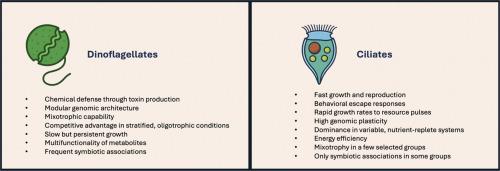Why do some dinoflagellates produce toxins, whereas ciliates rarely do?
IF 4.5
1区 生物学
Q1 MARINE & FRESHWATER BIOLOGY
引用次数: 0
Abstract
Dinoflagellates and ciliates dominate marine microzooplankton, yet widespread toxin production is largely restricted to dinoflagellates. This perspective synthesizes evolutionary, genomic, and ecological drivers of that asymmetry with direct relevance to harmful algal events. From a molecular and biochemical point of view, dinoflagellates possess vast, repeat-rich genomes that support modular PKS/NRPS pathways yielding chemically diverse metabolites, whereas ciliates generally lack complete PKS/NRPS clusters (apart from a few predatory lineages) and instead emphasize behavioral defenses and rapid reproduction. Most confirmed toxic dinoflagellates are photosynthetic or mixotrophic; robust cases in purely heterotrophic taxa are lacking. Despite environment-dependent costs, dinoflagellate metabolites confer grazer deterrence, allelopathy, prey lysis, and potential nutrient acquisition. Socio-economically, paralytic shellfish toxins (saxitoxins) produced by Alexandrium spp., Gymnodinium catenatum, and Pyrodinium bahamense—non-PKS alkaloids associated with sxt genes—are among the most consequential. An integrated approach coupling genomics, metabolomics, targeted bioassays, and in situ observations will clarify when chemical versus behavioral strategies prevail across ocean regimes, thereby improving HAB risk assessment, monitoring, and mitigation.

为什么有些鞭毛动物会产生毒素,而纤毛虫却很少?
鞭毛纲和纤毛虫是海洋微型浮游动物的主要动物,但广泛的毒素生产主要局限于鞭毛纲。这种观点综合了与有害藻类事件直接相关的不对称的进化、基因组和生态驱动因素。从分子和生物化学的角度来看,鞭毛虫拥有大量的、重复丰富的基因组,支持模块化的PKS/NRPS途径,产生化学上多样化的代谢物,而纤毛虫通常缺乏完整的PKS/NRPS集群(除了少数掠食性分支),而是强调行为防御和快速繁殖。大多数已证实的有毒鞭毛藻是光合或混合营养型的;在纯异养分类群中缺乏可靠的病例。尽管环境依赖的成本,鞭毛藻代谢物赋予食草动物威慑,化感作用,猎物裂解和潜在的营养获取。社会经济方面,由Alexandrium spp.、Gymnodinium catenatum和Pyrodinium bahameni产生的麻痹性贝类毒素(蛤毒素)——与sst基因相关的非pks生物碱——是最重要的。将基因组学、代谢组学、靶向生物测定和现场观察相结合的综合方法将澄清化学策略与行为策略在整个海洋环境中何时占上风,从而改进有害藻华风险评估、监测和缓解。
本文章由计算机程序翻译,如有差异,请以英文原文为准。
求助全文
约1分钟内获得全文
求助全文
来源期刊

Harmful Algae
生物-海洋与淡水生物学
CiteScore
12.50
自引率
15.20%
发文量
122
审稿时长
7.5 months
期刊介绍:
This journal provides a forum to promote knowledge of harmful microalgae and macroalgae, including cyanobacteria, as well as monitoring, management and control of these organisms.
 求助内容:
求助内容: 应助结果提醒方式:
应助结果提醒方式:


